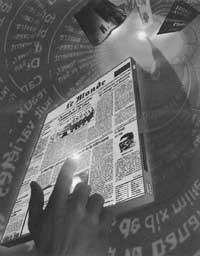Where do we read it?
Seeing that the year 2000 is so close, the following question is often asked: we in the future, on paper or on screen, where will we read it? The truth is that many scientists are working for us to receive books and newspapers through the computer screen.
For example, laboratories are preparing the electronic newspaper, but before this comes true it is necessary to solve some problems. The computer is much faster than paper to search for information, but reading on screen is more expensive than reading on paper. Do not forget that the computer screen has 72 points per inch and the normal printer has 300 points per inch.
In the Apple house they try to overcome this barrier and in the research laboratory of Xeros de Palo Alto of California they are also working on it. People want to read and simulate their relationship with paper through HD screens (minimum 600 points per square inch). They designed a small special computer.

This small computer is table-shaped and has two parts that open like the book. You will have an interface for loading data from the office computer or from the phone via the modem. Touching the buttons on the screen with the fingertips will pass the pages, increase the desired part or add both video and sound.
If you've been interested in an article, you can save it to a custom library in a dynamic finger size memory. In addition, the manuscript character recognition program will allow writing notes or highlighting some passages on the screen as on paper.
In order for this special computer we have described to be successful, it must meet above all two requirements. It should be easily accessible from Ba, that is, not having a greater complexity than it is normally available to read the magazine. On the other hand, and this is the main condition, it must be affordable by all, that is, very cheap. Fulfilling this second condition can have a lot to do with the ultraviolet “electron cannon” that they want to prepare at the Polytechnic School of Lausanne (Switzerland).
For the construction of very thin screens the liquid crystal system or the plasma cell system is currently used, but both are too expensive. We have already said that the small special computer for reading newspapers is a tablet that opens like the book. Therefore, the screen should be inserted in the thickness of centimeters that has the tablet. By juxtaposition of 15 millimeter diameter nanotubes in Lausanne, it is intended to achieve a screen of one centimeter thickness. The screen that forms glued together to these tiny cathodic tubes does not emit heat and the brightness of the image does not vary from any angle. However, it is estimated that the first prototypes will take about four years.
The book so widely used since the time of Gutenberg, however, has disadvantages over the e-book. In the ebook the “spin” does not affect costs. The same costs to make and distribute ten copies of the book or to make and distribute ten thousand copies. In addition, it is not necessary to use paper, cut trees to make paper in the forests, have the paper in the warehouses, transport it, etc.





